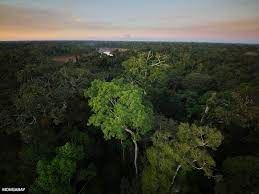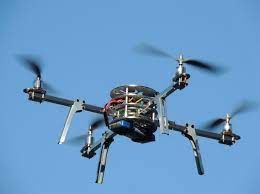UPSC Daily Current Affairs- 11th July 2023 | Current Affairs & Hindu Analysis: Daily, Weekly & Monthly PDF Download
| Table of contents |

|
| GS-I |

|
| About Yamuna River: |

|
| GS-II |

|
| GS-III |

|
| About Quadcopters: |

|
| LVM3: Unlocking New Frontiers of Space Exploration |

|
| Stages of LVM3: Powering the Journey to Orbit |

|
GS-I
Amazon Forests

Why in News?
According to Brazil's national space research agency, deforestation in Brazil's Amazon fell 34% in the first half of 2023 compared to last year's data.
Amazon Rain Forests
- Location:The region belongs to nine nations of the South American continent.It is bounded by the Guiana Highlands to the north, the Andes Mountains to the west, the Brazilian central plateau to the south, and the Atlantic Ocean to the east.
- Area Covered:The majority of the forest, 60%, is in Brazil, followed by Peru with 13%, Colombia with 10%, and with minor amounts in Bolivia,Ecuador,French Guiana, Guyana, Suriname and Venezuela.
- Climate: Hot and humid climate with temperatures of 26-30°C throughout the year.There are no periodic seasons.The precipitation ranges from 2,000 mm to 10,920 mm annually.
- Tribes:Yanomamo,Kayapo,Akuntsu,Matses,Tupi etc.
- Fauna:Anaconda,Jesus lizard,howler monkey, golden lion tamarin, jaguar,sloth, spider monkey,Amazon River dolphin,toucan and the scarlet macaw,poison dart frog and the glass frog.
- Flora:Moist broadleaf tropical rainforest like myrtle,laurel,palm, acacia,rosewood,Brazil nut,rubber tree, mahogany and Amazonian cedar.
Significance of the Rainforests
- Lungs of the planet:Rainforests generate about 20% of the world’s oxygen and its trees play a key role in reducing pollutant levels.
- Fight climate change:They act as a crucial buffer in the global fight against climate change as it holds tremendous capacity to store carbon.
- Medicinal Properties:Many of these plants contain bioactive compounds capable of treatmenting diseases that are not yet curable, especially cancer.
Threat to the forests
- Climate Change:Due to climate change the forests are witnessing various challenges like changes in rainfall patterns,pollution etc.
- Deforestation: The size of the Amazon forest shrank dramatically as a result of settlers’ clearance of the land to obtain lumber and to create grazing pastures and farmland.
- Wildfires:It causes threat to the survival of ecosystem and biodiversity.The 2019 forest fires in the region have led to widespread devastation in the region.
Amazon River
- It is the largest river by volume of water and second longest river after the Nile river of Africa in the world.It represents 20% of the global riverine discharge into oceans.
- Source:River has its source in the Peruvian Andes, at an elevation of 5,598 m.
- Length:6400 km.
- Basin:The basin includes the greater part of Brazil and Peru,some parts of Colombia, Ecuador and Bolivia and a small area of Venezuela.
- Tributaries:Japurá , Juruá, Madeira, Negro, Purus, and Xingu rivers.
- Mouth:Atlantic Ocean on the northeastern coast of Brazil.
Source: Indian Express
Churachandpur

Why in News?
The name ‘Churachandpur’ in Manipur is being challenged amidst ongoing violence in the region.
About
- Kuki-Zomi organizations have been using the name ‘Lamka’ instead, reflecting their desire for autonomy from the state’s Meitei leadership.
- Locals see it as a way of colonising, that’s why they are sentimental over the name. The consent of the local people was never taken to change the name in 1983. And secondly, Churachand Singh had never ruled there. It was the British who conquered us and took control of the administration.
Churachandpur
- Churachandpur district occupies the south-west part of Manipur state.
- The name ‘Lamka’ — which means ‘crossroads’ in Kuki dialects — can be traced to the 1917-1919 Anglo-Kuki War.
- The conflict was a result of Kuki chiefs opposing British demands for recruiting people in the Labour Corps for World War I (between 1914 and 1918).
- The name Churachandpur — which was first introduced in the area in 1921 — draws from Maharaja Churachand Singh, the king of the Manipur Kingdom from 1891 to 1941.
Source: Indian Express
Key Facts about Yamuna River

Why in News?
The Delhi government recently issued a flood warning as Haryana released more than one lakh cusecs of water into the Yamuna river from the Hathnikund barrage.
About Yamuna River:
- Yamuna River (also known as Jumna), is the major tributary of the Ganges River.
- Origin:It rises in the high Himalaya, in the Yamunotri Glacier, at the height of 4,421 meters.
- Course:
- The 1,376 km long Yamuna flows solely through India, crossing three states: Uttarakhand, Uttar Pradesh and Haryana.
- After rising in the high himalayas, it flows in a southerly direction swiftly through the Himalayan foothills and, exiting Uttarakhand, onto the Indo-Gangetic Plain, along the border between Uttar Pradesh and Haryana state to the west. The Eastern and Western Yamuna canals are fed from the river at that point.
- The Yamuna then passes Delhi, where it feeds the Agra Canal.
- South of Delhi, and now wholly within Uttar Pradesh, it turns southeastward.
- Near Prayagraj (Allahabad), after a course of about 855 miles (1,376 km), the Yamuna joins the Ganges (Ganga) River. The confluence of the two rivers is an especially sacred place to Hindus and is the site of annual festivals as well as the Kumbh Mela, which is held every 12 years.
- Tributaries:
- Near Dehradun, the capital city of Uttarakhand, the Yamuna is joined by its biggest tributary, the Tons River.
- The Chambal River is Yamuna’s biggest tributary on the right.
- Other important tributaries of the Yamuna include the Hindon, Sarda and Giri river on the right and Betwa and Sindh on the left.
Source: The Hindu
GS-II
Performance Grading Index for Districts (PGI-D)
Why in News?
The Performance Grading Index for Districts (PGI-D) combined reports for 2020-21 and 2021-22 were released recently.
About Performance Grading Index for Districts (PGI-D):-
- Released first: 2017-18.
- By: Department of School Education and Literacy (DoSE&L), Ministry of Education.
- Objective: to help the Districts to prioritize areas for intervention in school education and thus improve to reach the highest grade.
- The report the performance of the school education system at the District level by creating an index for comprehensive analysis.
- 83-indicator-based PGI-D has been designed to grade the performance of all districts in school education.
- Significance: The PGI-D is expected to help the state education departments to identify gaps at the district level and improve their performance in a decentralized manner.
- The indicator-wise PGI score shows the areas where a district needs to improve.
Methodology
- The PGI-D structure comprises of total weightage of 600 points across 83 indicators.
- These are grouped under 6 categories viz., Outcomes, Effective Classroom Transaction, Infrastructure Facilities & Student’s Entitlements, School Safety & Child Protection, Digital Learning and Governance Process.
- These categories are further divided into 12 domains.
- PGI-D grades the districts into ten grades viz., Daksh and Akanshi-3.
- Daksh: it is the Highest achievable Grade for Districts scoring more than 90% of the total points in that category or
- Akanshi-3: The lowest grade in PGI-D, which is for scores up to 10% of the total points.
PGI for districts report – 2020-21 & 2021-22
- The Covid Pandemic has affected the performance of districts during 2020-21 to 2021-22 as compared to 2019-20.
- None of the districts attained the top two grades.
- 79 districts made consistent improvement in PGI-D scores in the last 4 years.
- In spite of the Covid pandemic at its peak in 2021-22, 290 districts have made a notable improvement in their performance when compared to 2019-20 (pre-pandemic) with 2021-22.
- Overall, 194 districts have made grade level improvement in 2021-22 as compared to 2018-19.
Source: AIR
What Data Protection Bill needs to do to actually protect?
Why in News?
The government is reportedly introducing a revised version of the Digital Personal Data Protection Bill during the upcoming Monsoon session of Parliament. The article highlights the importance of including provisions on data portability and interoperability in the Bill.
Central idea
- The government is set to present a revised version of the Digital Personal Data Protection Bill. This presents a unique opportunity for the government to enhance the Bill by reintroducing provisions on data portability and introducing an interoperability provision.
What is the Digital Personal Data Protection Bill about?
- The Digital Personal Data Protection Bill aims to safeguard personal data of Indian citizens.
- It states how data should be stored, processed, and protected.
- The bill specifies obligations of data fiduciary for processing digital personal data and states practices they must follow to prevent data breach.
- It also defines consent of the data principal to provide such information
What is mean by Data portability and interoperability?
Data Portability:
- Data portability refers to the ability of individuals to transfer their personal data from one platform, service, or organization to another.
- It focuses on the movement and transfer of personal data, allowing users to take their data with them when they switch platforms or services.
- Data portability empowers individuals by giving them control over their personal information and the freedom to choose alternative platforms or services without losing access to their data.
Interoperability:
- Interoperability refers to the ability of different systems, platforms, or services to seamlessly exchange and use data with one another.
- It ensures that different technologies, applications, or networks can work together and communicate effectively, enabling data and information to flow between them.
- Interoperability allows for the compatibility and interaction of systems, promoting collaboration and communication across different platforms.
What is the Need for Empowering Users through Data Portability and Interoperability?
- User Control and Choice:
- Currently, users often find themselves locked into platforms or services that collect and utilize their data without much transparency or control.
- By enabling users to transfer their data and choose alternative platforms, data portability allows individuals to exercise their rights and make informed decisions about their data.
- Privacy and Data Protection:
- Users have the right to ensure that their personal data is handled responsibly and in accordance with their preferences.
- By facilitating data portability, individuals can move their data to platforms that prioritize privacy and security, incentivizing organizations to adopt stronger data protection practices.
- Fostering Competition and Innovation:
- Start-ups and smaller companies often face challenges in competing with established platforms due to the network effects and data lock-in created by dominant players.
- By allowing users to easily switch platforms while retaining their data, data portability enables start-ups to attract dissatisfied users and offer innovative alternatives, driving competition and fostering a dynamic market.
- User Empowerment:
- When users have the ability to freely move their data, platforms are incentivized to provide better services, respect user rights, and compete for user loyalty.
- This shift in power dynamics puts users in a more empowered position, encouraging platforms to prioritize user interests and enhance their overall digital experience.
- Cross-Platform Collaboration and Interaction:
- Interoperability allows users to communicate and engage with individuals on different platforms, breaking down the silos that currently limit cross-platform interaction.
- This promotes a more interconnected digital ecosystem and enhances user experiences by enabling seamless communication and data flow.
Potential concerns associated with data portability and interoperability
- Privacy Risks: The movement of personal data through data portability and interoperability raises privacy concerns, including unauthorized access, breaches, and misuse of information. Robust data protection measures are necessary to safeguard user privacy.
- Data Security: Data portability and interoperability add complexity to data security. Strong security protocols are needed to prevent unauthorized access, tampering, or loss of data.
- Standardization Challenges: Achieving universal standardization for seamless data transfer and interoperability is challenging due to the diverse range of technologies involved. Lack of standardization can hinder smooth data transfer and interoperability.
- Vendor Lock-in: While data portability aims to reduce vendor lock-in, some platforms may still implement practices that make it difficult to transfer data. This can limit user choice and freedom.
- Data Quality and Compatibility: Data transfer between platforms can result in compatibility and quality issues. Differences in data formats and standards can affect data accuracy, completeness, and reliability.
- Complexity and Technical Challenges: Implementing data portability and interoperability can be technically complex. It requires infrastructure, resources, and expertise to support seamless data transfer and compatibility.
Way forward
- Legislative Action: Governments must prioritize enacting comprehensive data protection laws with provisions for data portability and interoperability, establishing clear guidelines and enforcement mechanisms.
- Industry Collaboration: Stakeholders should collaborate to develop common protocols, formats, and standards for data portability and interoperability, prioritizing user-centric design, data security, and privacy.
- User Education: Governments and organizations should educate users about their rights regarding data portability and interoperability, raising awareness of benefits, risks, and processes involved.
- Privacy by Design: Organizations should adopt privacy by design principles, integrating data protection into platform and service design from the outset.
- Third-Party Verification: Independent entities can verify and audit data portability and interoperability practices, ensuring compliance with standards and building user trust.
- International Collaboration: Governments should engage in international collaborations to promote harmonized standards and regulations for cross-border data transfers.
- Continuous Review: Regularly reviewing and updating regulations and standards ensures adaptability to evolving technology and data governance challenges.
Conclusion
- Given the internet’s indispensability to modern life, it is imperative for the government to seize this opportune moment and enact legislation that supports user empowerment and innovation. By striking while the iron is hot, the government can create a more equitable and thriving digital landscape for all.
Source: The Hindu
GS-III
Quadcopters
Why in News?
Security forces in Manipur found the Meitei and Kuki factions using quadcopters to track and target their opponents in certain areas of the state.
About Quadcopters:
- It is an unmanned aerial vehicle (UAV) or drone with four rotors, each with a motor and propeller.
- A quadcopter can be manually controlled or can be autonomous.
- It's also called a quadrotor helicopter or quadrotor.
- It belongs to a more general class of aerial vehicles called multicopter or multirotor.
- Principle:
- The main principle behind the flight of a quadcopter is Newton's Third Law of motion, which states that for every action there's an equal and opposite reaction.
- A quadcopter's propellers push air downwards. This causes an opposite reaction called thrust that pushes the quadcopter upwards against gravity.
- Air movement comes from Bernoulli's Principle, with larger propeller blades and faster rotation creating more thrust.
- When the propellers rotate (for example clockwise), the quadcopter will tend to rotate anti-clockwise. Rotational force is called torque. Helicopters solve this by using a tail rotor.
- Quadcopters solve this by driving two diagonal propellers clockwise and the other two anti-clockwise. Thus, torque from one pair cancels that of the other.
- When each diagonal pair of propellers rotate in opposite directions, their thrusts will be in opposite directions. The quadcopter will not be able to lift up or fly.
- This is solved by having the blades of each diagonal pair of propellers shaped as mirror images of the other pair. Effectively, all propellers will push air downwards regardless of the direction of rotation.
- Applications:
- They provide stable flight performance, making them ideal for surveillance and aerial photography.
- Quadcopters, after being airborne, have the ability to hover in place, whereas fixed-wing aerial drones have to be on the move constantly.
- Other application areas include delivery, land surveys, crop assessment, weather broadcasting, and more.
- Quadcopters are an important part of future transportation called Advanced Air Mobility (AAM).
Source: Deccan Chronicle
LVM-3: the ISRO Rocket

Why in News?
ISRO is scheduled to launch the Chandrayaan 3 mission on July 14.
- The mission will be carried out using the LVM-3 configuration.
- The GSLV is used for heavier payloads and higher orbits, with the most powerful configuration known as LVM-3.
LVM3: Unlocking New Frontiers of Space Exploration
- Expendable Space Launch Vehicle: LVM3 is an expendable space launch vehicle meticulously crafted by ISRO.
- Purpose: Its primary objective is to deploy satellites and space objects into Geosynchronous Transfer Orbits (GTO).
- Launch History: ISRO successfully launched the first LVM3 on April 18, 2001, and has accomplished a total of 13 launches to date.
- Impressive Specifications: With a lift-off mass of 420 tonnes, LVM3 demonstrates its robustness in handling complex missions.
Stages of LVM3: Powering the Journey to Orbit
First Stage:
- S139 Solid Booster: The initial stage of LVM3 features the S139 solid booster, armed with 138 tonnes of propellant.
- Liquid Strap-on Motors: Additionally, it incorporates four liquid strap-on motors, each carrying 40 tonnes of propellant.
Second Stage:
- Liquid Engine: The second stage of LVM3 is equipped with a liquid engine, propelling the vehicle with 40 tonnes of liquid propellant.
Third Stage:
- Cryogenic Upper Stage (CUS): LVM3 showcases its technological prowess with the indigenously built CUS, capable of accommodating 15 tonnes of cryogenic propellants.
Source: The Hindu
|
38 videos|5293 docs|1118 tests
|


















